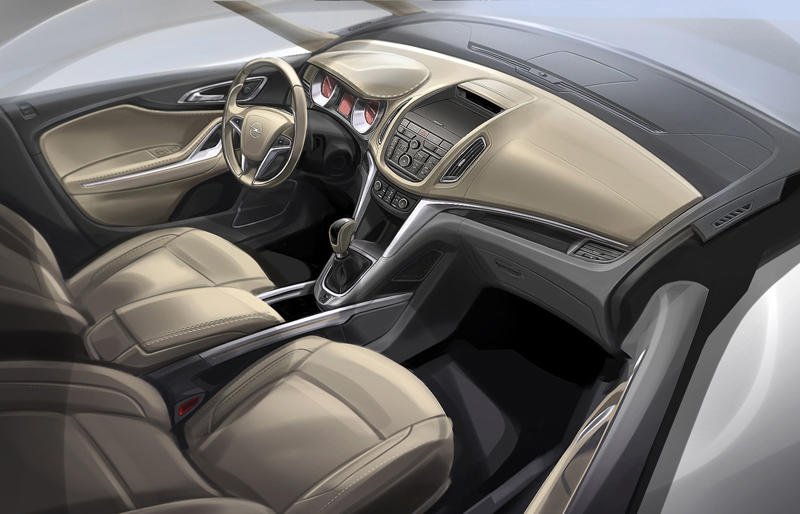When the first version was presented in 1999, the Opel Zafira was the first to offer seven seats in a mid-size vehicle; until then this had been the exclusive prerogative of large MPVs and maxi SUVs. A trend that was soon followed by many other models that were ready to adapt the boot into a practical third row of seats that were fixed or could be folded as required. Now on the market, the definitive version of the third generation of the multi-purpose with the Opel signature aroused a great deal of interest at the Frankfurt Motor Show where it made its debut. Not only because of a smart layout with more space and comfort among its trump cards, but also the technical design developed on the flagship Insignia platform that has allowed it to make a considerable technological leap compared to the previous Zafira. Contributing to this assessment are the engines – three petrol versions and three diesel, all turbocharged and particularly frugal fuel consumers – that give balanced performance even with the sporty options equipped on request, and generous 19”, 235/40 tyres.
A travelling lounge
To provide a spacious and comfortable interior in a body of just over 4.6 metres in length was the challenge for Opel technicians at the design stage. They responded by slightly lengthening the 2.76-metre chassis, widening the outside to almost 2.1 metres (mirrors included) and giving it a height of just over 1.68 metres, enough room even for tall passengers. Its silhouette reproposes all Opel’s latest stylistic precepts, the front first and foremost, with the highly characteristic radiator grill emphasized by the boomerang graphic of the headlights, a bonnet sloping seamlessly with the windscreen, a high door line with ribbed side panels, a wedge shape with a rear tapering slightly towards the spoiler on the roof.
A plus that is more technological than commercial is the availability of two extra seats in the rear that can be quickly pulled up or folded away simply by using one hand to operate the updated Flex7 system and thereby using the full interior seating space or adding to the capacity of the boot. What’s more, the seats are modular with original Lounge Seating in the second row, where the middle seat can be folded to create a table and at the same time give more room to slide the two 50mm outside seats towards the inside to make it more comfortable for stouter passengers. And when there are no passengers but only luggage or small packages, the boot has a variable capacity of 152 to 1860 litres.
Elective and Cosmo are the two versions of the internal layout which, in addition to the Insignia flagship platform, include refined elements like the optional panoramic windscreen that flows into the sunroof, or the FlexFix integrated bike carrier in the rear bumper that will carry up to four bikes. Handling and driving safety are ensured by electronic dynamic management in all driving modes. The heart of the system is the second-generation Opel Eye front camera combined with the radar-based Adaptive Cruise Control that maintains the distance from the vehicle ahead, Traffic Sign Recognition, with a repeater on the dashboard, Side Blind Spot Alert, Collision Imminent Braking, and Advanced Park Assist, which controls the steering wheel while the driver operates the brake and accelerator.
Ecoflex and methane
The range of engines has been completely changed compared to the Insignia flagship platform, at least for the petrol version. The Zafira’s engine is less exuberant but its performance is enviable. Although they might seem to be too small, the four-cylinder, 1.4-litre turbocharged petrol engines available in two configurations generate 120 and 140 HP, enough to move the Zafira’s 1570 kg. Of particular interest in the area of alternative fuels is the 1.6 Cng Turbo EcoM methane version, not only the most advantageous ecological alternative to diesel, but also the most powerful (150 HP) and fastest (204 km/h top speed) model of those in the Otto cycle.
Supercharging is the heart of the technology linked to the new downsized engines from the German group, smaller engines but with spectacular performance and ever lower emissions – and therefore consumption – of 158 g/km of CO2 for the petrol versions and 129 g/km for the methane version.
Two litres, instead, for the turbodiesel engine offered with 110, 130 and 165 HP maximum. Of these, the top model, like the most powerful of the two petrol models, is also available with automatic transmission and six gears, instead of the six-gear manual transmission which is standard in all versions. The intermediate 130 HP CDTI engine will soon be joined by the same EcoFlex version, the most ecological in the range fitted with Start&Stop, a new variable geometry turbocharger and specific tyres with low rolling resistance that will give an average of 22.2 km/litre and CO2 emissions reduced to 119 g/km. For all the others, traditional tyres are available in the four sizes 215/60 R16, 225/50 R17, 235/45 R18, up to the more generous 235/40 with stylish 19” rims.

-

Constructed on the Insignia flagship platform, the design of the new Zafira is typically Opel and emphasized by a wedge-shaped front with a sloping bonnet and characteristic double boomerang headlights

Many of the elements in the top range are to be found also in the wraparound shape of the wide, elongated dashboard with complete and rational instruments

Standard equipment in the Zafira includes elements that offer maximum safety, such as the front Opel Eye camera with radar technology that handles traffic sign recognition systems, intelligent cruise control and collision alert systems









